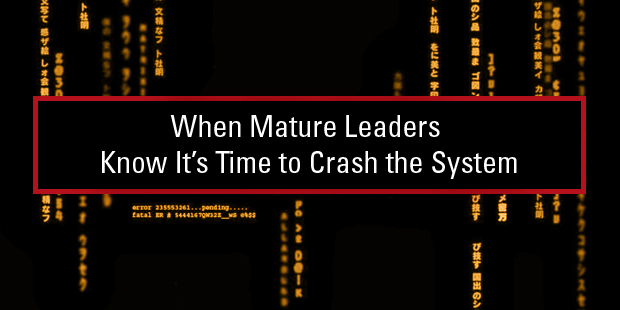
When Mature Leaders Know It’s Time to Crash the System
It’s happened on several occasions as I’ve worked in the publishing industry. An event, an issue, or a person comes across our collective radar screens in such a blazing fashion that we need to react. In this industry, it means publishing something.
But we have a publishing pipeline drawn up. It is the plan as to what and whom we will publish for the next 18-24 months. Sometimes even farther out. So, what do you do with interruptions that demand we change course?
We crash the system. It is the time when you break with the previous plan and do whatever it takes to get something published. Long hours of writing and editing. Crazy financial plans. Fast-paced graphic design. Last-minute printing contracts. Guerrilla marketing. You do whatever it takes to get the product into the marketplace.
With the teams I’ve led, we set up the following reasons for which we would crash the system:
- Author – a person arises who has a timely message or is such a significant personality that you would never turn them down.
- Customer Demand – Over a sustained period of time, we hear from customers about a subject that needs to be addressed.
- Cultural Issue – A major event in the culture occurs and it needs to be addressed immediately.
- World event – Headlines from a different part of the world for which believers should be aware and act upon.
- Corporate Interest – A person wishes to publish who holds influence over your board of directors or is an influential in your tribe of customers.
- Moment of Discernment – The sudden realization that we’ve missed addressing an issue for some time and seek to resolve the oversight.
- Spiritual Event – For good or bad, a spiritual movement is so evident in the world that it must be addressed.
Whenever we have crashed the system, it has felt like a wild ride. But, in the end, we’ve gotten a good return on the effort.
Church leaders also need to know when they should crash the system. It does not happen often but we should be ready for whenever it is appropriate. For pastors, it can mean changing a sermon to address a cultural and/or church issue of spiritual significance. For example, when the Supreme Court legalized marriage between homosexuals, the church needed to address the issue. Such is a reason to crash the system.
It can be localized to a particular congregation. If church leaders discover that many parents in their congregation are struggling with rebellious teenagers, then studies and personal discipleship relationships need to be ramped up. It is a time to crash the system by throwing aside the normal church events so you can address the new spiritual need.
We should be ready to crash the system for mission opportunities as well. If we suddenly discern a need that is present in the community that was not there previously, such as an influx of disconnected immigrants, it is time to crash the system of scheduled events and get busy doing outreach to your new neighbors.
The long-range (and short-term) plans of a church are usually mixed with a heavy dose of emotion. After all, everyone knows we are dealing with eternal realities. It sometimes makes it difficult to crash the system. You are suddenly interrupting groups, ministries, and other planned events. It requires that we talk about it now rather than later. As you train leaders in your church, prepare them for the inevitable crashing of the system. You must make flexibility based on ministry need a part of everyone’s spiritual perspective.
So, just as I led my publishing teams to think about why we would crash the system, do the same for your church leadership team. Here are the five reasons I would crash the system in our church.
1. Cultural Event. When events such as a tragedy or a shift in the moral landscape occurs, the church must address it and equip believers to give an answer for the hope we have in Christ.
2. Confrontation of Sin. Discovering a sin that is running rampant in the church should not be a cause for despondency but for action. If there is sin, there is no time for church fellowships, bounce houses, and business as usual.
3. Theological Problem. Church leaders need to keep an awareness of the theological temperature of a congregation. If a glitch in the system is found, it should be addressed swiftly and graciously.
4. Evangelistic Opportunity. Whether locally or internationally, as God gives your church the opportunity to push the gospel forward, we should be ready to respond at a moment’s notice.
5. Spiritual Awakening. I pray that one day soon we will see a spiritual awakening in the people of our country and a revival in the churches. When it happens, leaders must be ready to seize the moment.
Crashing the system is not to embrace chaos. Nor does it mean that we should cease long-range planning. In fact, the more spiritually attuned you are to God’s Word and His ways, the more likely your long-range planning will guide you to easily engaging ministry opportunities unknown to you at this moment. The willingness to crash the system is a sign of mature leadership; knowing that we must be leaders in the moment and not reactionaries after the fact.



































